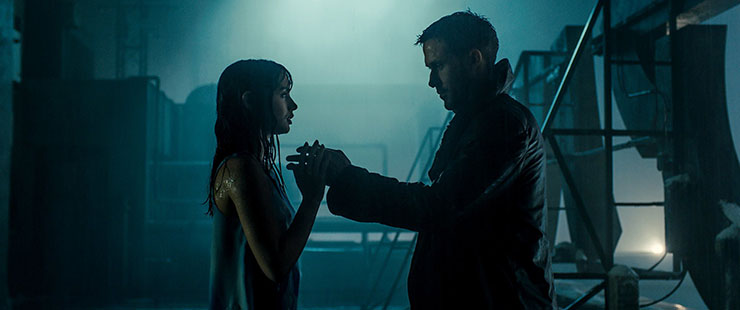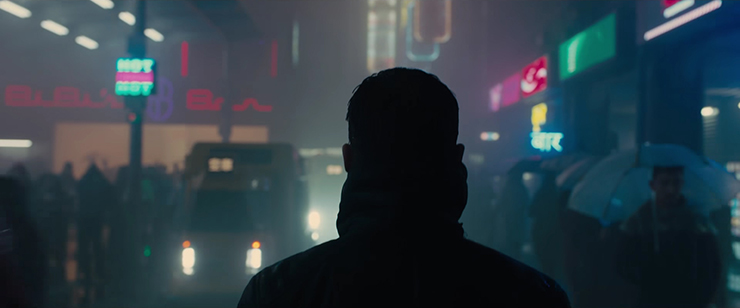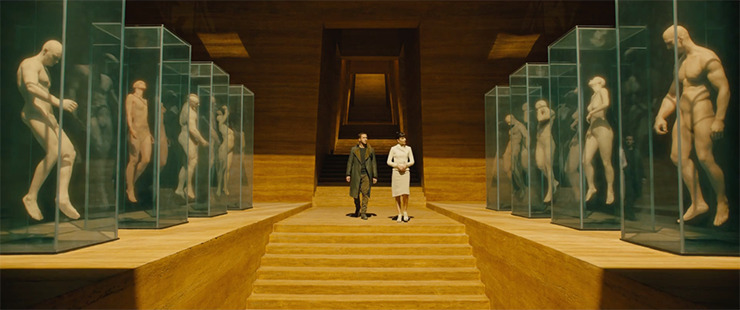
Left: Ryan Gosling | Right: Harrison Ford
At the brooding heart of Ridley Scott's “Blade Runner” lies the idea that humans put together in a lab are more adept at humanity than their “real” counterparts. Stronger, smarter, and yes, even capable of not just loving someone else, but being better at it. The “Alien” auteur was putting a futuristic spin on an old-fashioned detective tale, but it's clear that last part intrigued him just as much.
The 1982 box office underperformer turned out to be more memorable for its revolutionary production design than its nifty but remote exploration of artificial intelligence circa 2019, adapted from Philip K. Dick's 1968 novel “Do Androids Dream of Electric Sheep?”

Left: Jared Leto | Right: Ryan Gosling
Thirty-five years later, Scott has handed over the reins to Denis Villeneuve (“Prisoners,” “Sicario”) to return to this shiny, corroded future that's alienated audiences and polarized critics for so long. The announcement filled me with dread and apprehension. I've seen Villeneuve craft compelling stories of haunted people batling their demons, both in arthouse and studio-backed productions. But I have also seen how he approaches science fiction, in last year's “Arrival,” a film opened to critical acclaim and sturdy box office but also put this reviewer to sleep, hobbled as I found it by its wet blanket of a protagonist (sorry, Amy) and dearth of levity.
I sat in the dark confines of a vibrating Dolby auditorium and braced for the worst. And, as it turns out, my worries were unfounded. “Blade Runner 2049” not only lives up to the promise of its predecessor; it expands on its universe in bold, arresting directions. In significant ways, this gorgeously rendered epic, forged in synthetic skin and the tattered remains of broken dreams, is a clearer, more nuanced and more humane portrayal of fake humans, here called replicants, striving to survive, to simply be, in a world that has nothing but hostility and scorn for them.

Ana de Armas, Ryan Gosling
And few resent that second-class treatment more than “K,” a Los Angeles cop tasked with chasing down and “retiring” others like him. It's been 30 years since fellow law enforcer Rick Deckard (Harrison Ford) and experimental replicant Rachael (Sean Young) did their vanishing act, and the quality of life on Earth has taken even more of a tumble. We're told about these dire conditions in the lengthy (and necessary) captions that open the film, but it's cinematograher Roger Deakins and production designer Dennis Gassner who make us feel the faded glory of these dilapidated landscapes that nevertheless still possess an intoxicating grandeur.
Warner Bros., the studio releasing the film they co-financed with Sony, has been adamant in asking us critics to remain tight-lipped about plot details. Their concern is understandable; “2049” is particularly susceptible to spoilers, so I will tread lightly. At the home of a rogue replicant, K, played by a perfectly cast Ryan Gosling, finds a box containing a secret that spooks his superior, Lt. Joshi (Robin Wright), enough to ask him to discard the evidence and erase all traces. But K decides to violate protocol and start digging. The discovery reaches the ears of Niander Wallace (Jared Leto), a visually impaired replicant manufacturer with a God complex, who sends right hand woman Luv (Sylvia Hoeks) to, um, contain the situation.

Ryan Gosling
If this all sounds like a hard-boiled yarn unfolding at breakneck speed, well, not quite. Villeneuve is in no hurry to let these plot strands intersect. This is a deliberately paced “policier” that, like the original, is equally concerned with bringing a futuristic California to tactile life. Look elsewhere for your fix, action junkies, and don't judge “2049” for what it isn't.
At the same time, the vibe the French Canadian director sustains is markedly different from Scott's, and feels distinctly his own, while also paying tribute to what the 1982 film accomplished. And that includes introducing Joi (Cuban actress Ana de Armas), a holographic program that happens to be K's live-in girlfriend. A lesser film would have glossed over their scenes of domestic bliss, an oasis from the gathering storm outside their apartment. Joi is perky, caring and nurturing, and at one point, it becomes difficult to pinpoint the line between where the computer program ends and where genuine sparks begin.
De Armas (“War Dogs”) is magical, and her ethereal glow balances out the pessimistic outlook on display elsewhere, brilliantly conveyed in literal fashion by Deakins' chiaroscuro tableaux. (Just give him the Oscar already. Can you believe he's never won?) She's this dark film's blinding soul.

Ryan Gosling, Sylvia Hoeks
Villeneuve is also paying tribute to other filmmakers who braved these waters before him. If you ask me to describe what seeing “2049” feels like, it's as if Christopher Nolan had tried to remake “Metropolis.” The ambition and scope certainly recall Fritz Lang, but there are also scenes with a spartan austerity that bring to mind Russian filmmaker Andrei Tarkovsky.
From a thematic point of view, I was also reminded on more than one occasion of Alfonso Cuarón's “Children of Men” and to a lesser extent of Steven Spielberg's “Minority Report,” itself adapted from Dick's work.
The bottom line is that all the elements that I find irksome about Villeneuve are here: the slow-burn pacing, the somber gravity. But he has never combined them so judiciously. This is a quantum leap for him. He has made a soulful, richly transporting film that submerges us into these androids' dreams until we feel like they're our own. It's wonderful.




